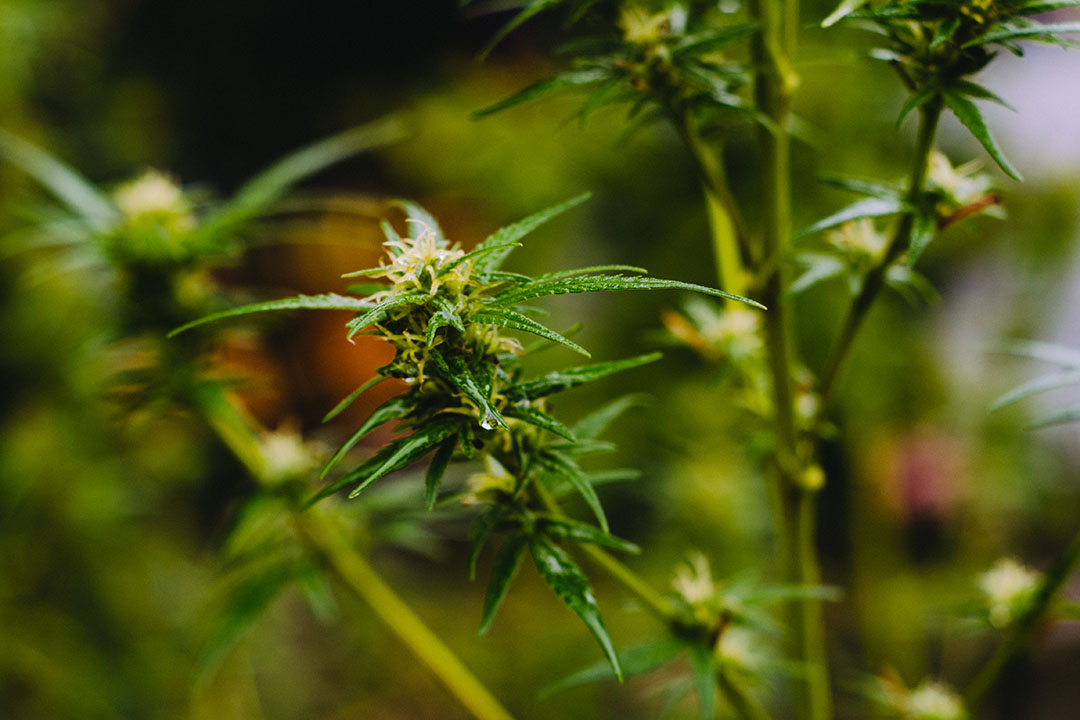The Physiology of Cannabis Terpenes and Terpenoids – A Brief Overview Leave a comment
Terpenes and terpenoids play a vital role in the health and wellbeing of plants as a whole. They’re produced by plants – not for an animal’s benefit, but for their own – in order to communicate with one another, to stop certain animals and insects from eating them, and serve as communication molecules to signal other plants, as well as attract pollinators such as bees.
The difference between terpenes and terpenoids is that terpenes are often made only of carbon and hydrogen, while terpenoids on the other hand incorporate other molecules, of the most common being oxygen, into their molecular structure.
Terpenes and terpenoids can be one of three different molecular structures: acyclic, monocyclic and polycyclic.
Acyclic means the molecule has no carbon rings in its structure, monocyclic means it has one carbon ring, and polycyclic means it has more than one carbon ring.
There are between 20,000-30,000 named terpenes and terpenoids in the plant world that have so far been discovered, of which over 200+ can be found in cannabis – making it the plant with the richest terpene profile known to science.
In order to help you pick what kind of weed to buy based on what your wants or needs might be, we’ve decided to pick 5 terpenes found in cannabis you’ll likely be familiar with and describe how they work within the body. We’re hoping this will help you narrow down your shopping list with us and get you the right bud!
Myrcene
This monoterpene is found all throughout nature in plants such as hops, mangos, bay leaves and a large array of other spices and herbs like thyme and parsley. Myrcene is the dominant terpene in modern cannabis strains, although that was not always the case. Market trends have dictated a higher demand for “couch lock” weed strains and since myrcene is responsible for “couch lock” – even more so than high CBD – it is believed to have strong sedative effects in elevated doses. High myrcene strains remained relatively uncommon until recent decades as the demand for highly sedating weed has suddenly skyrocketed. Before then, a different terpene, beta-caryophyllene,t was the dominant one found in cultivated cannabis.
Myrcene helps with pain, mood, muscle spasms, sleep and relaxation.
Strains we carry high in myrcene include Venom OG , Bruce Banner , and UK Cheese
Limonene
Limonene, a citrus terpene, is a compound found commonly in nature. So much so that it is the second most common terpene found in the wild. It’s found in citrus, lemon grass, dill, chives, and hundreds of other plants. There are many subtypes of Limonene. For example, D-Limonene is the terpene found in citrus fruits.
Limonene is an uplifting and relaxing terpene. When we inhale limonene, we feel a heightened sense of internal awareness and calm. When you smell an essential oil containing limonene, or a cleaning product, or a tea – you feel soothed, relaxed, and centered. The reason for this relaxation is Limonene.
Limonene’s effects include: reducing anxiety, helping stabilize mood, reducing the symptoms of depression, and to aid with sleep by reducing stress levels in the body.
Strains we carry high in limonene include: Black Mamba and El Jefe .
Alpha-Pinene
Alpha-Pinene is much less common in modern commercial cannabis plants, but is the most common terpene in nature overall. Selective breeding and consumer trends had selected this terpene out in the majority of cultivated cannabis, although some growers still produce strains with more traditional amounts of alpha-pinene. Alpha-pinene is primarily found in pine trees, conifers, rosemary, and eucalyptus, and sage. topical oils we use to treat skin irritations, abrasions, and muscle complaints.
Alpha-Pinene’s effects are in stimulation rather than sedation and relaxation. It helps with focus, energy, and helps counteract the effects of THC induced memory loss by inhibiting the breakdown of the memory molecule acedocoleine.
Linalool
A floral terpene, Linalool is another common terpene in nature. Purple plants typically have linalool as their dominant produced terpene although there are some exceptions to this such as birch trees, citrus, and coriander – which are all high in linalool yet are not purple colored.
Linalool is known for its sedative and relaxing effects, its anti-inflammatory effects, and is also a powerful anti-convulsive. Cannabis strains which are naturally higher in linalool may be best used to extract cannabis oils for medical uses because of these relaxing and anticonvulsant effects. For it’s relaxing and anti-inflammatory effects, it is commonly used in body washes and soaps.
Purple strains, mostly indicas and indica dominant hybrids, are high in linalool.
Beta-Caryophyllene
We saved the most interesting terpene for last. Beta-caryophyllene is a terpene, as well as a cannabinoid. How is that possible? Cannabinoids and Terpenes are both produced in the trichomes of the cannabis plant which are most abundant in the unfertilized female plant’s top flower structures. Beta-caryophyllene is the second most common terpene in cannabis as a result of this dual status. Aside from cannabis, peppers, licorice, peppercorn, oregano, clove, cinnamon and other such spices are all high in b-caryophyllene.
Known effects of this terpene are: anti-inflammatory effects, antimicrobial effects, gastrointestinal pain relief, and general pain relief. The reason for these effects is due to the dual status as a cannabinoid. Because of the molecular structure, beta-caryophyllene binds to the CB2 receptors of the body’s endocannabinoid system. CB2 receptors are the same receptors responsible for the medical benefits of CBD.
A strain we carry high in beta-caryophyllene is Peanut-Butter x Banana , Purple Space Cookies , and Banana Split
Bonus Info – The Entourage Effect
The Entourage Effects is a term used to describe the synergy of compounds such as different terpenes and cannabinoids for promoting optimal health through having all the compounds working together. Cannabis plants each have distinct terpene and cannabinoid profiles comprising hundreds of compounds present which are present throughout the plant. Isolates, although effective, are possibly not as effective as multiple compounds being used together. Further research is needed, but the theory is interesting nonetheless.
We hope you enjoyed this educational article on terpenes! Remember to check out the strains mentioned to see which is right for you!
References
Terpenes & Terpenoids | Presented by Dr. Jamie Corroon
Cannabis Terpene Alpha Pinene | Effects, Research & More
Cannabis Terpene Linalool | Effects, Research & More
Cannabis Terpene Beta Caryophyllene | Effects, Research & More
Cannabis Terpene Limonene | Effects, Research & More
Cannabis Terpene Myrcene | Effects, Research & More
Top 5 Terpene Reference Chart, by Andrea Meharg, 2018, www.revealcannabis.com


